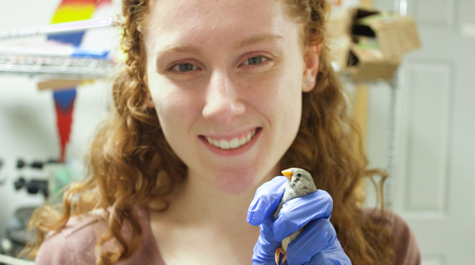by Joseph McClain | October 8, 2020
Most people have seen it: a bird on the ground under a window, lying stunned, splayed, dead or dying.
John Swaddle cites studies that say as many as a billion birds are lost to window strikes each year, and he adds that many of the measures to reduce window collisions are not esthetically pleasing and often are ineffective.
Swaddle is the faculty director at William & Mary’s Institute for Integrative Conservation as well as a professor in the university’s Department of Biology. He and a group of graduate students in biology have published a paper evaluating a new window-film product designed to reduce bird-window collisions.
The paper, “Ultraviolet-reflective film applied to windows reduces the likelihood of collisions for two species of songbird,” was published recently in the open access, peer-reviewed journal PeerJ. It’s the first paper to come out of the IIC, a new initiative at William & Mary. Swaddle’s co-authors are Lauren Emerson, Robin Thady and Timothy Boycott.
The paper reports on the group’s analysis of BirdShades, a commercially produced window treatment designed to reduce bird collisions, but the co-authors say their improved experimental methodology is likely the more important contribution. Swaddle has been working on the problem of bird-structure collisions for years. He is one of the founders of Sonic Nets and Acoustic Lighthouse, initiatives that offer possible solutions to problems that arise in bird-human relationships.
“BirdShades is a small startup company in Austria,” Swaddle said. “They reached out to me a couple of years ago, as they were starting to think about how to get into the window collisions business.”
He said that he had served as an informal advisor to the firm, and when BirdShades had a prototype product, they needed an outside party for testing and Swaddle’s team was available.
BirdShades is an adhesive film designed to be applied to window glass. It’s advertised as invisible to humans, but its ultraviolet-reflective nature appears as solid to birds. Swaddle’s group found that BirdShades-treated windows reduced the likelihood of window collisions by 75 to 90 percent in certain tests.
The numbers are impressive, but it’s complicated. Swaddle said the group’s contributions are more nuanced — and more valuable — than those numbers suggest. The BirdShades tests gave them a chance to refine and improve the standard methodology for window-strike studies.
“One of the big problems with how other people have tested window products is they’ve largely done them in the dark,” he explained.
The usual methodology to test the bird-window relationship involves a large, dark container, Swaddle said. Often it’s a converted shipping container. The researchers cut a couple of holes in the far end and install windows. Then, the birds fly through the dark container toward the lighted windows, to be caught, unharmed, in a mist net before they would come to grief against the target panes.
“That inverts the whole light situation in comparison with the usual scenario of a bird flying around your garden and hitting the window of your house,” he explained. “Because in that situation, the bird is flying in bright daylight, hitting a window that has a more or less illuminated artificial light behind it. And people weren’t testing birds in that situation.”
Further, he said, standard window-strike methodology uses a “forced-choice” paradigm: the bird flies toward a pair of windows; one pane is treated and the other is the untreated control window.
The group originally included forced-choice scenarios in their BirdShades testing, and then realized that such an artificial scenario isn’t true to life.
“If a bird is at risk of flying into your garden windows, it’s not because one window has a treatment on it and the other one doesn’t. You either have window treatments on all your house windows, or you don’t,” Swaddle said.
In other words, the forced choice is a false choice. The group suggested in their paper that the forced-choice methodology was at least partially responsible for those promising numbers indicating a 75 to 90 percent reduction in strikes on BirdShades-treated panes.
“We realized that this artificial choice that birds were being given by other testers is not particularly appropriate,” Swaddle said. “So, the comparison you need to make is when the birds are facing windows that are all treated with a film versus a situation when all the windows are not treated with a film.”
The group set out to abandon the dark-tunnel/forced-choice paradigm, starting with redesigning the flight tunnel. Boycott took the lead in experiment construction, saying he wanted to keep one aspect of the dark tunnel setup: birds were naturally attracted to literal light at the end of the tunnel when they were released.
“I was keen to use that natural tendency in bird behavior,” Boycott said. “So we started building a flight corridor that the first half of it was darkened. You would release the bird and it would still fly toward the light.”
The second portion of the corridor is lighted, providing a more true-to-life experience. After completing the side-by-side tests, the group ran a second set of trials. The experimenters eliminated the forced-choice scenario by installing the same kinds of glass in both panes and recording how the birds reacted in separate trials of BirdShades versus plain glass. The researchers used GoPro cameras to record bird behavior and velocity. They also took notice of birds that avoided the windows entirely.
Emerson said they used two species of birds. One species was the zebra finch. Zebra finches are domesticated and adaptable. They are commonly used in avian experiments and therefore understood to have vision that would detect the ultraviolet reflection that was the basis of the BirdShades effect.
“We also wanted a wild bird,” she said, “something that is abundant in the area and relatively easy to catch. We found that to be the brown-headed cowbird.”
They were able to secure more than a dozen cowbirds and Emerson said that the wild cowbirds did very well in captivity. In all of their tests, the group recorded reduction in the velocity of the birds when they approached the treated windows.
Swaddle points out that velocity matters. A bird hitting a window at twice the speed of another chalks up a kinetic splat that’s the square of the slower bird. If a bird has a chance to slow down, it has a much better chance of survival.
“I think an interesting result is that we saw this reduction was not as strong in the cowbirds as it was in the zebra finches,” Thady said. “We spent some time speculating about that.”
She explained that the cowbirds were faster fliers than the finches, so one possible explanation is that the cowbirds were going down the corridor at such a clip that sometimes they couldn’t slow down in time. “And they were overall better at avoiding the windows,” she said. “That stood out to me in particular.”
They found that the BirdShades glass worked, but the effect in their more realistic all-control vs all-treated trials was consistently smaller than what they found in the forced-choice experiments. When the birds did not have to choose a pane, around 50 percent of zebra finches and 30 percent of brown-headed cowbirds showed they would avoid the BirdShades glass.
These figures compare to the forced choice situation of the “side-by-side” trials that logged avoidance results of approximately 90 percent in zebra finches and 75 percent in brown-headed cowbirds.
Swaddle says he intends to continue his bird-collision research and hopes to continue to engineer more effective and relevant research methods. He said he is pursuing an avenue of inquiry that would involve fitting sensors to windows that attract a lot of bird strikes.
“The standard way for people to collect data on bird collisions is to go around the buildings early in the morning and count how many dead birds are on the ground,” he said. Sensors could count the birds that bounce and survive, and the right sensor could even log the force and identify the type of bird, or at least the size, he said.
“We could get better information on how common bird collisions actually are,” Swaddle said. “Until we have good data on the collisions themselves, we’re not going to do very well testing mitigation products in real life situations.”
For now, people concerned with window strikes can pursue a number of remedies, some of which are more effective than others. Swaddle said that in addition to new-generation film treatments such as BirdShades, there are existing film products that usually have a visible striping or darkening pattern and have shown some. He doesn’t recommend window stickers, though.
“The decals that seemed to be popular among some people were the sort of silhouettes of animals or birds,” he said. “They don’t tend to work in part because they’re generally too spaced out. And they’re not giving good information to the birds visually. So I would recommend avoiding those.”



